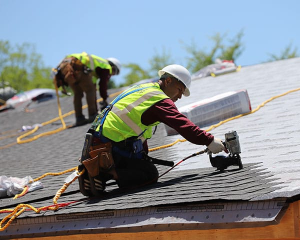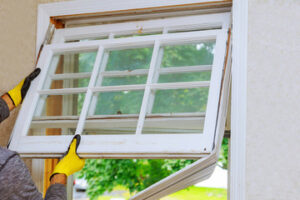The roof is the shield that protects us from the elements. It is both a functional and aesthetic component of any building. Its form and materials have evolved to suit building types, climates, and aesthetic preferences.
The most common roofing material is asphalt shingles. They are relatively inexpensive and versatile. Other roofing materials include wood shingles and shakes which provide a natural aesthetic, and metal panels which are available in a range of colors. Contact Buckeye Roofing of Columbus now!

As with any home improvement project, the success of a roofing job depends on two things: workmanship and materials. A quality roof requires a durable material that can withstand high winds and hail, as well as protect the interior of your house from sunlight. Fortunately, there are plenty of options available to meet these requirements.
Asphalt shingles are the classic roof covering that you see on most homes. They are inexpensive and easy to install, and they come in a variety of styles and colors. They are also a good choice for flat and low-pitched roofs.
Another option is metal roofing, which can be made to resemble other types of materials such as slate, shakes or tile. Metal is long-lasting and fire-resistant, and it has an attractive appearance. However, it can be expensive and is more difficult to repair than other types of roofing.
Other types of roofing materials include clay tiles and concrete tiles, which are durable and affordable. They are a good choice for areas with frequent storms, and they help to reduce cooling costs by reflecting solar radiant heat.
Wood shingles are made from sawn bolts of cedar or other types of wood, and they can last for up to 30 years. They are a durable choice for high-wind regions, but they can be damaged by snow or hail. Wood shingles are also susceptible to mold and mildew growth, and they can absorb water, which can lead to rot.
Slate is a durable roofing material that comes in a wide range of thicknesses and colors, and it has a lifespan of up to 100 years. It is very heavy, so it requires a strong roof structure. It can be difficult to find a roofing services company that specializes in slate installation, and it is more expensive than other types of roofing.
Concrete and clay tiles are another durable option that can withstand heavy rains, wind, and hail. They are often recommended for areas prone to earthquakes, tornadoes or hurricanes. They are also a good choice for insulating your house, and they can reduce cooling costs by 10-25%.
Installation
The roof is the outer protective covering of a home or building, keeping it safe from weather and other elements. A home’s roof also acts as its main source of natural light and ventilation. It is a critical component to the overall structure and function of a building, so it must be durable, strong, and aesthetically appealing. The roof must be able to resist fire, water, hail, snow, and high winds.
The first step in installing a new roof is to prepare the area. The roofing crew will set up tarps to protect landscaping and shrubs from debris, as well as cover open drains to prevent debris from blocking them. They will move any furniture and vehicles to a protected area, ensuring nothing gets damaged by falling materials.
Once the tarps are in place, the roofing contractor will begin the installation process by nailing down the underlayment. This is a waterproof membrane that goes under the shingles and reduces the risk of water infiltration. The roofer will then install the first row of shingles, starting at the bottom edge and working their way up to the ridge. They will overlap the shingles and nail them in a staggered pattern to avoid gaps. For extra protection, they may add ice and water sheathing to the areas where the shingles meet the walls.
In addition to the shingles, roofers will also install any vents, skylights, or chimneys. They will also replace the gutters, downspouts, and trim. The vents should be positioned to allow for adequate airflow through the attic, which will help with cooling and energy efficiency. A vapor retarder can be added to the attic to further reduce moisture, but this is optional and not necessary for most homes.
Once the roofing work is complete, a final inspection will be conducted to ensure all aspects of the project comply with local building codes and are aesthetically pleasing. The inspector will check for adherence to standards and identify any potential issues that need to be addressed.
Maintenance
The roof is a building’s primary protection against the elements. Consequently, it requires regular maintenance to extend its service life and reduce operating costs. Untreated deterioration will eventually result in costly repairs and interior damage. Maintenance procedures should be tailored to each roofing system, as well as the environmental conditions in which it is installed.
Surface maintenance involves the cleaning and treatment of roof surfaces to extend their service life and help prevent leaks. This includes removing organic growths (moss, algae), debris, and clogged drains. It also includes inspecting the underlayment for water penetration, which is often a cause of leaks even when the surface is intact.
Other surface maintenance items include examining the shingles for loose or cracked pieces, or those that have lost their protective granules (which accelerates shingle deterioration). It is advisable to check the condition of flashing around penetrations and skylights; a faulty seal can allow water to seep into the structure through these openings.
A routine inspection of the roof surface should be conducted by trained personnel, preferably on a biannual basis. This enables early detection of problems and allows them to be addressed quickly and economically, before they become serious.
Before performing a rooftop inspection, a safe work area must be established. This is particularly important if there are electrical or dangerous materials on the roof, or if the building supports heavy equipment and machinery. Safety procedures should include ensuring proper signage is posted and that all personnel are aware of any hazards associated with specific tasks on the roof, such as walking on fragile vegetation, climbing steep slopes, or working with power tools or piping. Also, an appropriate level of caution must be exercised when stepping over areas that are covered with snow or ice.
Repairs
Roofs take a beating from weather, extreme temperatures and even trees and other debris. They’re a big investment and, over time, they may need repairs or even replacement. Leaks (often indicated by water stains on ceilings or walls), chimney flashing issues, damaged shingles and sagging are just some of the problems that can occur. Proactive maintenance and a yearly inspection can catch these before they cause serious damage.
Structural changes, including replacing the entire roof or adding solar panels, typically require a permit. A licensed contractor who’s familiar with NYC permitting can help. Full tear-offs also need Landmark District and Historic Building approvals and an architect-designed plan. A proper permit can save you a lot of headaches down the line. This is a job that requires stamina, strength and safety awareness.
